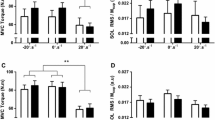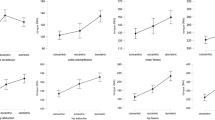Summary
Six healthy women (21.8±0.4 y) did isometric strength training of the left plantarflexors at an ankle joint angle of 90°. Training sessions, done 3 times per week for 6 weeks, consisted of 2 sets of ten 5 s maximal voluntary contractions. Prior to and following the training, and in random order, voluntary and evoked isometric contraction strength was measured at the training angle and at additional angles: 5°, 10°, 15°, and 20° intervals in the plantarflexion and dorsiflexion directions. Evoked contraction strength was measured as the peak torque of maximal twitch contractions of triceps surae. Training increased voluntary strength at the training angle and the two adjacent angles only (p<0.05). Time to peak twitch torque was not affected by training. Twitch half relaxation time increased after training (p=0.013), but the increase was not specific to the training angle. There was a small (1.1%, p<0.05) increase in calf circumference after training. Evoked twitch torque did not increase significantly at any joint angle. It was therefore concluded that a neural mechanism is responsible for the specificity of joint angle observed in isometric training.
Similar content being viewed by others
References
Alway SE, MacDougall JD, Sale DG, Sutton JR, McComas AJ (1988) Functional and structural adaptations in skeletal muscle of trained athletes. J Appl Physiol 64:1114–1120
Bender J, Kaplan H (1963) The multiple angle testing method for the evaluation of muscle strength. J Bone Joint Surg 45 A:135–140
Davies CTM, Young K (1983) Effects of training at 30 and 100% maximal isometric force (MVC) on the contractile properties of the triceps surae in man. J Physiol 336:22–23P
Davies CTM, Dooley P, McDonagh MJN, White MJ (1985) Adaptation of mechanical properties of muscle to high force training in man. J Physiol 365:277–284
Duchateau J, Hainaut K (1984) Isometric or dynamic training: differential effects on mechanical properties of a human muscle. J Appl Physiol: Respirat Environ Exercise Physiol 56:296–301
Gardner GW (1963) Specificity of strength changes of the exercised and nonexercised limb following isometric training. Res Quart 34:98–101
Gonyea W, Bonde-Petersen F (1978) Alterations in muscle contractile properties and fiber composition after weight-lifting exercise in cats. Exp Neurol 59:75–84
Komi PV (1986) Training of muscle strength and power: interaction of neuromotoric, hypertrophie and mechanical factors. Int J Sports Med [Suppl] 7:10–15
Knapik JJ, Mawdsley RH, Ramos MU (1983) Angular specificity and test mode specificity of isometric and isokinetic strength training. J Orthopaed Sports Phys Ther 5:58–65
Lindh M (1979) Increase of muscle strength from isometric quadriceps exercises at different knee angles. Scand J Rehab Med 11:33–36
Marsh E, Sale D, McComas AJ, Quinlan J (1981) Influence of joint position on ankle dorsiflexion in humans. J Appl Physiol: Respirat Environ Exercise Physiol 51:160–167
McDonagh MJN, Hayward CM, Davies CTM (1983) Isometric training in human elbow flexor muscles. The effects on voluntary and electrically evoked forces. J Bone Joint Surg 65:355–358
Meyers CR (1967) Effects of two isometric routines on strength, size, and endurance in exercised and nonexercised arms. Res Quart 38:430–440
Raitsin LM (1974) The effectiveness of isometric and electrostimulated training on muscle strength at different joint angles. Theory Prac Phys Cult 12:33–35 Translated in Yessis Rev Soviet Phys Educ Sport 11:35–39
Rasch PJ, Pierson WR (1964) One position versus multiple positions in isometric exercise. Am J Phys Med 43:10–12
Rasch PJ, Pierson WR, Logan GA (1961) The effect of isometric exercise upon the strength of antagonist muscles. Int Angew Physiol Einschl Arbeits Physiol 19:18–22
Sale DG (1988) Neural adaptation to resistance exercise. Med Sci Sports Exerc 20:S 135-S 145
Sale DG, MacDougall JD (1981) Specificity in strength training: a review for the coach and athlete. Can J Appl Sport Sci 6:87–92
Sale D, Quinlan J, Marsh E, McComas AJ, Belanger AY (1982) Influence of joint position on ankle plantarflexion in humans. J Appl Physiol: Respirat Environ Exercise Physiol 52:1636–1642
Sale DG, Upton ARM, McComas AJ, MacDougall JD (1983) Neuromuscular function in weight-trainers. Exp Neurol 82:521–531
Thépaut-Mathieu C, Van Hoecke J, Maton B (1988) Myoelectrical and mechanical changes linked to length specificity during isometric training. J Appl Physiol 64:1500–1505
Vandervoort AA, Quinlan J, McComas AJ (1983) Twitch potentiation after voluntary contraction. Exp Neurol 81:141–152
Author information
Authors and Affiliations
Rights and permissions
About this article
Cite this article
Kitai, T.A., Sale, D.G. Specificity of joint angle in isometric training. Europ. J. Appl. Physiol. 58, 744–748 (1989). https://doi.org/10.1007/BF00637386
Accepted:
Issue Date:
DOI: https://doi.org/10.1007/BF00637386




